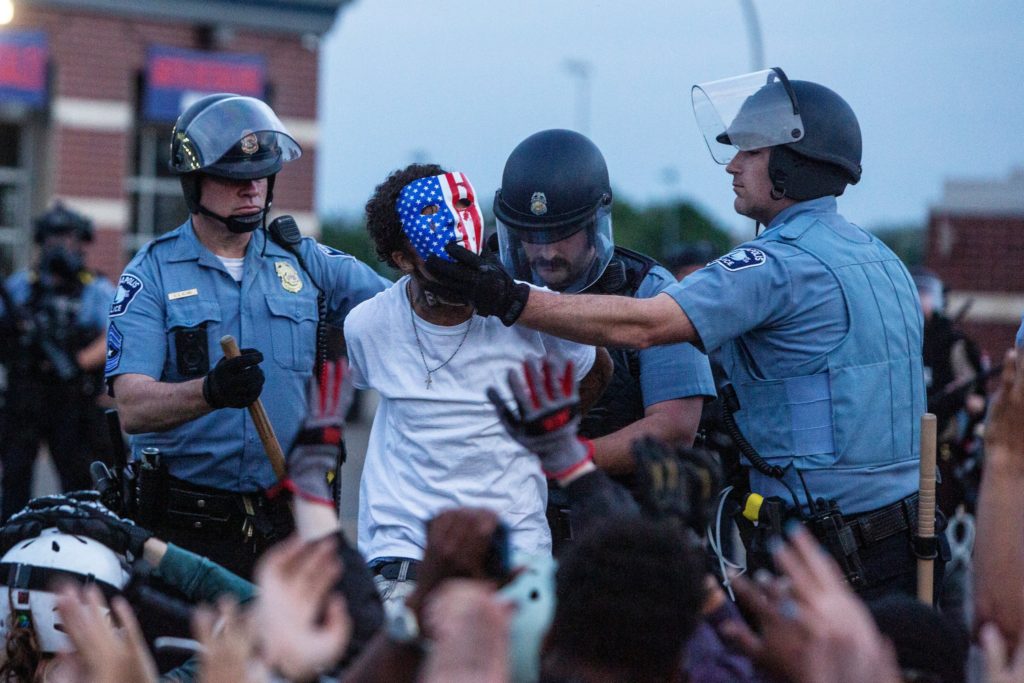Anti-racist protests lead to police reforms across the U.S.

Victor J. Blue for The New York Times
By Solange Reis*
When it comes to the wave of anti-racism protests in the United States, it is inevitable to compare the years 1968 and 2020. The trigger in both cases was the murder of a Black man by a white one.
Back then, activist Martin Luther King (MLK) was killed by someone who had a criminal record, but no political motive. This year, George Flloyd was killed by police officers for no extreme reason. MLK was a unique leader; Flloyd was one more ordinary man killed by law enforcement agents.
MLK’s murder speeded the passage of the Civil Rights Act of 1968. That legislation brought some changes, such as ending legal discrimination in the real estate market. The law also made it a federal crime to threaten or use violence based on race, color, religion, nationality, physical disability, or marital status.
Around fifty years later, protests as expressive as those ones want to prevent Flloyd from being one more statistic. They claim for an end to police violence against Black people and police reforms. What is happening today in the United States could also unfold to a significant impact on this year’s election outcome.
Violence in uniform
The Civil Rights Act was not able to entirely go from paper to practice. Admittedly, there was some progress. Yet the United States remains a country with sharp racial inequality, as the gap spans various aspects of society and normalizes the police brutality against African Americans.
Embedded in such a chronic context ends Flloyd’s story – a citizen murdered by police and the system against which MLK has committed his life. On May 25, under the suspicion of trying to use a counterfeit bill to buy cigarettes, he was arrested, immobilized, and killed by a policeman assisted by three others. His neck was pressed against the asphalt by Derek Chauvin’s knee for nearly nine minutes until Flloyd stopped breathing. A teenager bypasser captured the violence with her camera, in broad daylight on a busy street in the city of Minneapolis.
Flloyd is not the first Afro-American to be cowardly murdered by security forces. Those stories are frequent and eventually result in impunity. They consist of unauthorized death sentences in a society which legal system allows capital punishment in thirty of fifty states. An arbitrariness that the Black community in Brazil knows pretty well too.
The standpoint of speech takes to the streets
MKL and Flloyd’s destiny may coincide not only in the tragicness but in its consequences. Where Flloyd’s story ends, countless protests begin. And they could lead to significant changes, as hundreds of thousands of people are taking to the streets to demand a permanent halt to police violence against Blacks. “No justice, no peace,” outcries one of the mottoes of the demonstrations.
In many points during the protests, the reaction came with even more truculence. At first, some police departments, governors, politicians, and the president claimed that the manifestations were outlawed, referring to occasional fires and looting. In their view, the “riots” were anarchical, and force must restore order. By actual military force, if necessary. Republican Senator Tom Cotton asked for precisely that in his criticized New York Times article that ended with the resignation of a newspaper editor.
President Donald Trump even threatened to implement the 1807 Insurrection Act, which allows military troops to fight rebellions, regardless of governors’ will. Most military personnel did not support his idea. Even the Department of Defense published a disagreement note signed by current Secretary Mark Esper, a definite sign of non-cohesion inside the government.
Trump’s countermarch
A proof of the anti-democratic character of the current government towards these demonstrations was the president’s walk from White House to St. John’s Church, which burned in the events on the eve. Trump wanted to speak and have his picture taken there, yet not in support of the protesters, but to denounce them as “agitators.” Though, in between the White House and the church, there was Lafayette Square taken by demonstrators. For him to cross it, the crowd was violently dispersed, including the press.
Although Attorney-General William Barr was the one who gave the order, the decision shows a government vision. In addition to threatening to deploy the military, Trump challenged governors to act harshly and urged police to shoot demonstrators. His attitude, however, may cost him essential support. In a very affirmative video, Chief of Staff General Mark Milley showed civility and veiled criticism of Trump. In front of a cadet group, said the general:
“Equality and opportunity is a matter of readiness. It’s the basis of cohesion. We fight wars as teams, and we cannot tolerate anything that divides us. Let me conclude with two simple pieces of advice, based on 40 years in uniform, that you may find useful as many of you will surely go on to be flag officers. First, always maintain a keen sense of situational awareness. As senior leaders, everything you do will be closely watched, and I am not immune as many of you saw the result of the photograph of me at Lafayette Square last week, which sparked a national debate about the role of the military in civil society. I should not have been there. My presence at that moment and in that environment created a perception of the military involved in domestic politics. As a commissioned uniformed officer, it was a mistake that I’ve learned from, and I sincerely hope we all can learn from it.”
Materializing the violence
Police violence against Blacks is deeply related to U.S. historical build-up, and the way society developed after slavery ended. Institutional instruments that enable security apparatuses violence are added to such a racist culture, making the unequal approach between white and Blacks a sort of commonplace.
An essential tool in such a paradigm is the Department of Defense’s 1033 Program, which allocates surplus military equipment to civilian forces. Researches show that those transfers are directly related to increased police violence. Using military gear, such as armored vehicles, grenade launchers, gas masks, and M4 rifles used by NATO, requires specialized training. Therefore, police officers end up incorporating both mentality and equipment for fighting external enemies. With racism ingrained and an excess of equipment and military training, internal war by police against Blacks is normalized.
Another resource that steams police brutality and unfairness is a legal doctrine known as ‘qualified immunity.’ This principle states that police officers hold procedural immunity unless a civil action brought against them proves an out-of-law behavior. That seems simple, but it is not. Typicality must be verified by case law, i.e., a particular abuse needs a precedent proven one. Not merely by approximation, but a likelihood. While police officers cannot use a stun gun against a driver, they may apply it to a prisoner. To be successful, legal action by that prisoner would need to be based on a previous and victorious judicial case by another inmate.
Those are nearly impossible missions for prosecutors, even if judges consider the complaint constitutionally legitimate. All that makes it extremely hard for a system to change through legal channels. Between 2013 and 2019, 99% of cases involving crimes committed by police officers did not result in a conviction. Blacks are three times more likely than whites to die at the hands of a police officer. And police violence does not necessarily relate to crime levels in cities.
What’s Next?
Recent protests will not change racist relationships in American society, at least not in the short term. Even in MLK’s time, the government was well aware of that. The 1968 Kerner Commission was set up by President Lyndon Johnson to map the picture. Its conclusions were emphatic: legal achievements were not practiced, with Blacks continuing to be victims of “police misconduct, economic inequality, segregated housing, and inferior education.”
Current demonstrations, however, will affect police structure and behavior. Across the country, local leaders are making plans to restructure, resize, or even shut down police departments. In California, even police unions are putting up a project. And in New York, the police department itself will review its practices.
Way out through politics
Democrats have placed a package of measures in the House of Representatives with early support from senators to end the use of stun guns and qualified immunity. The bill also aims to establish independent committees to examine abuse cases, demands compensation for victims or their families, and finally makes lynching a federal crime.
Republican Party, which has only one Black federal senator among its members, is also studying reforms in the police. It does not want to fall behind the opposition, now that the movement gained widespread approval. A Washington Post poll shows 87 percent of Democratic voters, 79 percent of Independents, and 53 percent of Republicans in favor of the protests.
As things evolved contrarily to what the ‘law and order’ president wanted, Trump rushed to show some action. On June 16, he signed an Executive Order creating independent organizations to verify the de-escalation of police violence, the banning of chokehold (unless necessary), and the creation of programs for police officers to better deal with non-threatening situations. Mild steps for a president whom a majority of voters (61%) consider having dealt with the situation in an unsatisfactory way.
A more comprehensive step was taken in Colorado, on June 13, when state Senate passed sweeping reforms. Among them was a ban on stun guns and chokeholds. Besides, police officers banned from one security agency shall not find a new job in others.
There is also demand for police de-militarization, even without an official militarized police corporation like in Brazil. The criticism aims at some type of weapons and training given to civilian police officers. Such a goal is not easy to achieve, mainly because police rely on strong unions, with the National Fraternal Order of Police being the most influential. Even when cases reach the legal field, arbitrators often authorize the return to work of offending police officers.
De-militarization is a considerable challenge. There have been seven bills against Program 1033, but none got to voting. In 2015, following anti-racist protests due to the killing of a Black man by police, an Executive Order from President Barack Obama prohibited transferring certain types of military weapons to law enforcement departments. Two years later, Trump repealed the measure.
Options for improvement will occur more quickly at municipal and state levels, with funds cuts and police role redefinition. Intense protests in the last two weeks and economic crisis brought on by the Covid-19 pandemic could favor such reform types. Many emergency services could be done by social workers or nurses, such as assisting people with a drug overdose, mental problems, or homelessness situation. Transferring that kind of task would please Democrats on agenda adequacy and would have Republican support as it would mean less cost. Positive experiences, as such, have occurred in locations that vetoed increasing in security force figures and prioritized the hiring of social workers.
Legitimacy crisis and elections
Other anti-racism protests have rocked the country between 1968 and 2020. This time, however, there is an evident legitimacy crisis in security forces. That stands out as everything else also declines, such as health system, economy, jobs, environment, and short-term prospects. The spread and tenacity of current manifestations indicate a change probability, yet far from ideal.
Even if demonstrations run out of steam – despite similar deaths after Flloyd’s – their effects in coming elections will be sure. On the one hand, a president with a racist background whose loyal electoral base is not much kneen to Black Live Matters cause. His party, on the other hand, has understood that the winds are blowing in favor of the ongoing demands. So, there is a potential watershed between Trump’s interests and his party buddies. On the other side of the ballot is Democrat Joe Biden, a relatively insipid and inconsistent competitor, but with acceptance by the Black community and a party that has less to lose by supporting protests than the ruling one.
* Ph.D. in Political Science at Unicamp, collaborator professor at San Tiago Dantas Graduate Program in International Relations and researcher at the National Institute of Science and Technology for Studies about the United States (INCT-Ineu).
** Article received on June 16, 2020. This article does not necessarily reflect the opinion of OPEU or INCT-INEU.





















